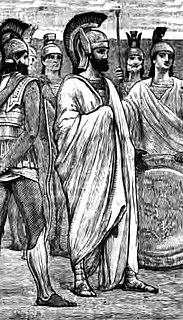
Agesilaus II, was a king (basileus) of the ancient Greek city-state of Sparta and a member of the Eurypontid dynasty ruling from 398 to about 360 BC, during most of which time he was, in Plutarch's words, "as good as though commander and king of all Greece", and was for the whole of it greatly identified with his country's deeds and fortunes. Small in stature and lame from birth, Agesilaus became ruler somewhat unexpectedly in his mid-forties. His reign saw successful military incursions into various states in Asia Minor, as well as successes in the Corinthian War; however, several diplomatic decisions resulted in Sparta becoming increasingly isolated prior to his death at the age of 84 in Cyrenaica.
This article concerns the period 409 BC – 400 BC.
This article concerns the period 399 BC – 390 BC.
This article concerns the period 379 BC – 370 BC.
This article concerns the period 389 BC – 380 BC.

Lysander was a Spartan admiral who commanded the Spartan fleet in the Hellespont which defeated the Athenians at Aegospotami in 405 BC. The following year, he was able to force the Athenians to capitulate, bringing the Peloponnesian War to an end. He then played a key role in Sparta's domination of Greece for the next decade until his death at the Battle of Haliartus.
Year 395 BC was a year of the pre-Julian Roman calendar. At the time, it was known as the Year of the Tribunate of Cossus, Medullinus, Scipio, Fidenas, Ambustus and Lactucinus. The denomination 395 BC for this year has been used since the early medieval period, when the Anno Domini calendar era became the prevalent method in Europe for naming years.
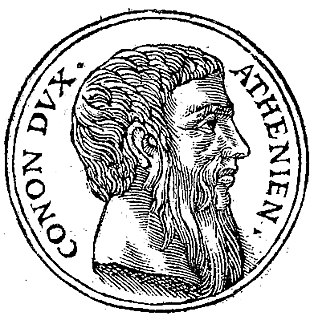
Conon was an Athenian general at the end of the Peloponnesian War, who led the Athenian naval forces when they were defeated by a Peloponnesian fleet in the crucial Battle of Aegospotami; later he contributed significantly to the restoration of Athens' political and military power.

Antalcidas, son of Leon, was an ancient Greek soldier, politician, and diplomat from Sparta.

Artaxerxes II Mnemon was the King of Kings of the Achaemenid Empire from 404 BC until his death in 358 BC. He was a son of Darius II and Parysatis.
The polis of Sparta was the greatest military land power of classical Greek antiquity. During the classical period, Sparta governed, dominated or influenced the entire Peloponnese. Additionally, the defeat of the Athenians and the Delian League in the Peloponnesian War in 431-404 BC resulted in a short-lived Spartan dominance of the southern Greek world from 404 to 371 BC. Due to their mistrust of others, Spartans discouraged the creation of records about their internal affairs. The only histories of Sparta are from the writings of Xenophon, Thucydides, Herodotus and Plutarch, none of whom were Spartans. Plutarch was writing several centuries after the period of Spartan hegemony had ceased. This creates difficulties in understanding the Spartan political system, which was distinctly different from any other Greek polis.
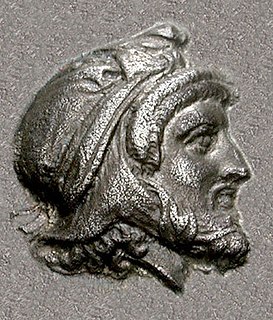
Pharnabazus II was a Persian soldier and statesman, and Satrap of Hellespontine Phrygia. He was the son of Pharnaces II of Phrygia and grandson of Pharnabazus I, and great-grandson of Artabazus I. He and his male ancestors, forming the Pharnacid dynasty, had governed the satrapy of Hellespontine Phrygia from its headquarters at Dascylium since 478 BC. He married Apama, daughter of Artaxerxes II of Persia, and their son Artabazus was likewise a satrap of Phrygia. His grand-daughter Barsine married Alexander the Great.

The Corinthian War was an ancient Greek conflict lasting from 395 BC until 387 BC, pitting Sparta against a coalition of Thebes, Athens, Corinth and Argos, backed by the Achaemenid Empire. The immediate cause of the war was a local conflict in northwest Greece in which Thebes and Sparta intervened. The deeper cause was hostility towards Sparta, provoked by that city's "expansionism in Asia Minor, central and northern Greece and even the west". The Corinthian War followed the Peloponnesian War, in which Sparta had achieved hegemony over Athens and its allies.

The Battle of Coronea in 394 BC, also Battle of Coroneia, was a battle in the Corinthian War, in which the Spartans and their allies under King Agesilaus II defeated a force of Thebans and Argives that was attempting to block their march back into the Peloponnese.
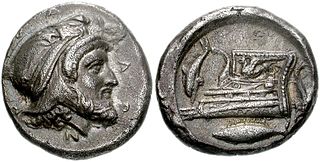
The Battle of Cnidus was a military operation conducted in 394 BC by the Achaemenid Empire against the Spartan naval fleet during the Corinthian War. A fleet under the joint command of Pharnabazus and former Athenian admiral, Conon, destroyed the Spartan fleet led by the inexperienced Peisander, ending Sparta's brief bid for naval supremacy.
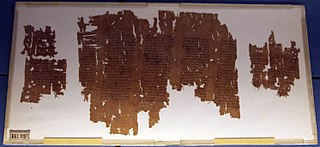
Hellenica simply means writings on Greek (Hellenic) subjects. Several histories of 4th-century Greece, written in the mould of Thucydides or straying from it, have borne the conventional Latin title Hellenica. The surviving Hellenica is an important work of the Ancient Greek writer Xenophon and one of the principal sources for the last seven years of the Peloponnesian War not covered by Thucydides, as well as the war's aftermath.

The Battle of Haliartus was fought in 395 BC between Sparta and Thebes. The Thebans defeated a Spartan force attempting to seize the town of Haliartus, killing the Spartan leader Lysander. The battle marked the start of the Corinthian War, which continued until 387 BC.
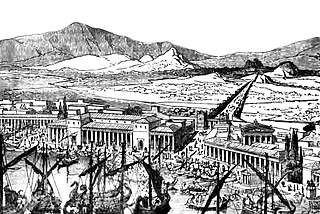
Although long walls were built at several locations in ancient Greece, notably Corinth and Megara, the term Long Walls generally refers to the walls that connected Athens main city to its ports at Piraeus and Phaleron. Built in several phases, they provided a secure connection to the sea even during times of siege. The walls were about 6 km in length, initially constructed in the mid 5th century BC, destroyed by the Spartans in 403 BC after Athens' defeat in the Peloponnesian War, and rebuilt again with Persian support during the Corinthian War in 395-391 BC. The Long Walls were a key element of Athenian military strategy, since they provided the city with a constant link to the sea and thwarted sieges conducted by land alone.

The Battle of Nemea, also known in ancient Athens as the Battle of Corinth, was a battle in the Corinthian War, between Sparta and the allied cities of Argos, Athens, Corinth, and Thebes. The battle was fought in Corinthian territory, at the dry bed of the Nemea River. The battle was a decisive Spartan victory, which, coupled with the Battle of Coronea later in the same year, gave Sparta the advantage in the early fighting on the Greek mainland.

Classical Greece was a period of around 200 years in Greek culture. This Classical period saw the annexation of much of modern-day Greece by the Persian Empire and its subsequent independence. Classical Greece had a powerful influence on the Roman Empire and on the foundations of Western civilization. Much of modern Western politics, artistic thought, scientific thought, theatre, literature and philosophy derives from this period of Greek history. In the context of the art, architecture, and culture of Ancient Greece, the Classical period corresponds to most of the 5th and 4th centuries BC. The Classical period in this sense follows the Greek Dark Ages and Archaic period and is in turn succeeded by the Hellenistic period.












